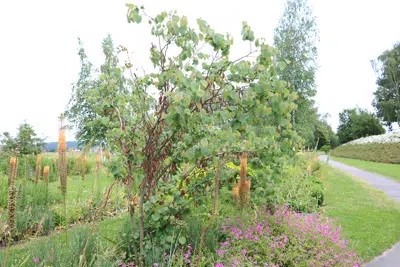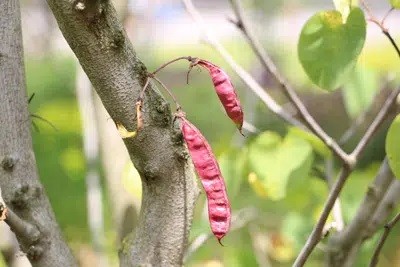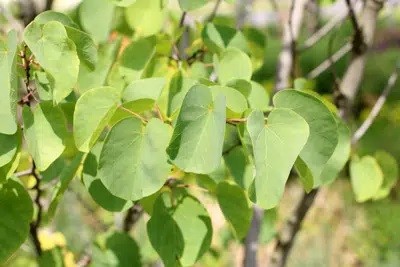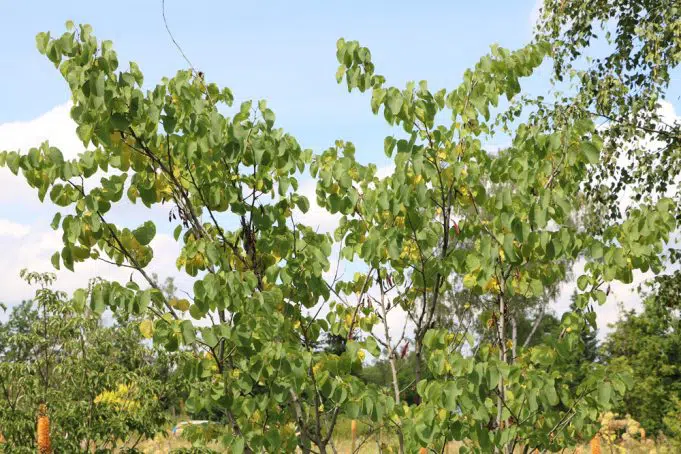The Judas tree or common Judas tree shows a lush flowering splendor early on, which can shine in pink, red or white. As a tree or shrub, it also creates an exotic flair with its unusual pods and yet can do without costly care. This makes the ornamental shrub suitable for almost any garden and even for amateur gardeners without green fingers and extensive botanical knowledge.
Contents
- 1 Properly plant the Judas tree
- 2 Edible flowers
- 3 Are Judas trees poisonous?
- 4 Choose a suitable location
- 5 What care is necessary?
- 6 Care in the tub
- 7 Watering and fertilizing
- 8 Is transplanting or replanting necessary?
- 9 Pruning
- 10 Safe wintering
- 11 Wintering of potted plants
- 12 When can potted plants be put outdoors again?
- 13 Propagate
- 14 Propagation by seed
- 15 Propagation by cuttings
- 16 Diseases and pests
- 17 Conclusion
- 18 Author
Properly plant the Judas tree
The Judas tree can be grown as a shrub, a tree with a spreading crown or a tall ball tree. Small varieties or young plants do not need to be planted in the garden for this, the first few years they can certainly stand in a tub on the balcony or terrace.
Judas trees can grow up to six meters high and in exceptional cases even up to 13 meters. For this they need a while with an annual growth of up to 50cm, nevertheless, the ornamental shrub should be planted with foresight.
The ideal time for planting is spring, after the last frost.

Edible flowers
Cercis has lush inflorescences that can be found not only along the young shoots and branches, but also on the stems. This makes the Judas tree an exotic addition – on the balcony, terrace and in the garden.
However, the flowers are not only beautiful to look at, they are also edible. As a decoration in the salad they conjure up a great contrast and bring a touch of exoticism with their subtle flavor here as well.
Are Judas trees poisonous?
While the flowers are edible, the leaves, pods and seeds can be slightly toxic. Consumption, especially by children and animals, should therefore be avoided.
Choose a suitable location
The Judas tree originates from warm regions and therefore needs a suitable location. Protected from the wind but still sunny, the deciduous tree should stand. For example, on the south side of a house. But also south-facing corners in the garden, screened by hedges or other trees, make ideal locations. Despite the necessary protection, the planting site must receive as much direct sunlight as possible.
In addition, it should be noted that the Judas tree grows relatively tall and the crown can be very expansive. So the plant should have enough distance from other plants. And also from stone paths, concrete slabs and buried walls. This is because the root runners, usually after injury, take on a length of several meters. Even ground coverings, which are located at a seemingly safe distance, can be significantly damaged by them.
Site for the tub plant
Even as a tub plant, the Judas tree needs a sunny, warm place where it is protected from cold wind. Balconies and terraces facing south are ideal.
However, care should be taken with locations where the heat accumulates too much. These can become too much even for the Judas tree. Especially very young plants should then be provided with some shade, at least in midsummer.
Suitable substrate
Judas trees need a water-permeable substrate that is calcareous. Somewhat nutrient-rich, moist loam soil is an optimal base for healthy growth. If this is not available or if the Judas tree is planted in a container, the use of trough soil is recommended.
Waterlogging must be urgently avoided. Occasional drying out of the soil, on the other hand, is no danger, as the Judas tree is extremely drought-resistant.
What care is necessary?

The Judas tree is an easy-care ornamental shrub that rarely needs watering when planted freely in the garden. If the Judas tree has been planted in an optimal location and the right substrate has been chosen, fertilization is usually not necessary.
Only shaping pruning and removal of dead parts may be necessary from time to time, but this should be done carefully.
In winter, young plants and more sensitive varieties, such as the Chinese Judas tree, require additional winter protection.
Care in the tub
If the Judas tree is planted as a shrub or ball tree in a container, it needs a little more care than if it is free-standing in the garden.
Water the Judas tree in the tub as needed, the substrate should be kept moderately moist.
- Avoid waterlogging urgently
- Remove dead plant parts
- Fertilize lightly during the strong growth phases
- Change the soil if necessary
Watering and fertilizing
In rainy years and without extended dry periods, free-standing Judas trees usually do not need additional watering. Only when it gets very warm should watering be done.
Otherwise, the substrate can be kept slightly moist, but the plants do not tolerate waterlogging.
In the tub is necessary to adjust watering as needed.
- Use soft water, such as rainwater, for watering.
- Pay attention to the permeability of the substrate
- Avoid waterlogging
Tip: Collect rainwater or let tap water stand for several days to remove lime and soften it
Allow the substrate to dry only slightly between waterings, urgently avoid long dry periods.
As mentioned above, Judas trees require additional fertilization only as container plants. In the garden, provided the right location and the appropriate substrate, free-standing plants do not require additional nutrients.
Exceptions are growth problems, survived diseases or pest infestations. In these cases, they may be supplemented with a highly diluted complete fertilizer, blue grain or lime.
In the tub, the same means are recommended.
- Judas trees can be quickly overfertilized, so work only with strong dilutions
- Use additional nutrients carefully
- In the garden, fertilize only when necessary

Is transplanting or replanting necessary?
Judas trees that stand freely in the garden, can generally do without transplanting. Thus, a regular change of location is not necessary in the normal case.
However, if the nature of the substrate changes, the location proves unsuitable or the roots of the ornamental tree spread too much, the Judas tree can usually be moved without any problems. At least, provided that he is still relatively young.
Transplanting in a tub is possible without problems and great effort.
- Choose spring for transplanting and repotting
- Ensure as large a root ball as possible when repotting.
- Relocate large, older plants with suitable machinery
Protection from the roots
The roots of Judas trees can spread very far, damaging paths and walls. Placing a root protection sheet can prevent such consequences, but to do so, it should be placed at a suitable distance at the time of planting.
Pruning
The Judas tree or Cercis, as these plants are called by their Latin name, do not require regular pruning. However, shaping pruning is quite possible if done gently and carefully.
In contrast to many other plants, radical pruning should not be carried out, as the Judas tree will take it badly and lose its natural beauty.
- Prune a maximum of one third of the branch length
- Remove dead parts of the plant regularly and scarcely
- Prune Judas tree in spring or autumn
Note: Always use sharp, clean knives and scissors, this protects the plant and reduces the risk of invading pests and pathogens.
After pruning, apply a light fertilizer, this will speed up re-sprouting and promote dense growth.
Safe wintering
Older Judas trees are usually hardy and frost-resistant, so they do not require special winter protection. However, this can not do any harm in particularly harsh and long winters. Judas trees that are protected in this way usually sprout again faster and stronger. They are also less susceptible to parasites and diseases.
Young Judas trees, on the contrary, are very sensitive to frost and cold wind. Freely planted in the garden cercis, therefore, you should in any case during the first three to five years to protect against minus straight by several layers of garden fleece, straw and piled brushwood.
Wintering of potted plants
Placed in a tub on the balcony or terrace, the Judas tree lacks winter hardiness. The roots can not spread far enough in this type of planting and are more susceptible to low temperatures.
So here it is necessary to move the container to a frost-free area. For example, in a cellar or a reasonably cool room. If the Judas tree is wintered indoors, it should be placed as brightly as possible. However, the living room is still unsuitable because Judas trees benefit from winter dormancy.
- Protect young Judas trees planted in the garden with mulch, leaves, grass clippings, brushwood, straw and fleece.
- Overwinter potted plants indoors
- Do not exceed 15°C
- Place in a bright place
When can potted plants be put outdoors again?

Potted plants should only be put back on the terrace or balcony when snowfall and frost are safely over. This means that the temperatures have roughly adjusted to those in the winter quarters.
Additional protection of the tub and thus the roots may be advisable in the early stages, when night frosts cannot yet be ruled out or the location is not too sheltered.
Propagate
Judas tree can be propagated by seeds and by cuttings. However, both variants are somewhat difficult and do not guarantee propagation success.
Propagation by seed
Judas trees produce pods that contain several seeds. As soon as these dry, they can be removed from the Judas tree and opened.
- store dissolved seeds in the refrigerator for a week
- soak seeds in a bowl of water at room temperature
- leave in water for about a day
- place swollen seeds in growing medium and cover lightly with substrate
- germinate in a bright place at 20°C to 23°C
- germination time is about four weeks
- Keep the substrate moist and evenly warm during the entire time
- Young plants about ten centimeters high, they should be pricked out
- Propagation by seed can be done indoors throughout the year.
Propagation by cuttings
Propagation is possible by cuttings in addition to seed germination. However, like the first variant, this is not always crowned with success and requires some patience.
- Remove 15cm long shoots from the mother plant in summer.
- Insert shoots about 5cm deep in growing soil, to increase the chances of rooting aid with bring in
- Keep the substrate moist and place the cuttings in a warm, bright place.
- Cuttings can also remain outdoors
- in a protected place additionally cover with foil
- Root formation is noticeable by new shoots on the cuttings
- can take several weeks or even months
“Tip: To take the cuttings, use a sharp, germ-free knife and cut the cuttings at an angle. This protects against disease and improves the chances of root formation.
Young plants are sensitive to cold in the first year and should be moved indoors in the fall. So planting in pots or containers is recommended.
Diseases and pests
Judas trees are relatively insensitive to specific diseases and parasites. However, they can still be affected. For example, from the wilt, for which harmful fungi are responsible. In this case, the water veins in the wood turn sickly brown, this can be easily detected when cutting a branch. If the cercis is affected by this disease, it is usually unsalvageable and must be destroyed along with the surrounding soil.
If other symptoms appear, such as signs of feeding, fungal coatings or brown leaves, the location, growing conditions and care should be investigated. If necessary, commercial pesticides can also be used.
Tip: The best remedy against diseases and parasites is an optimal location and proper care
Conclusion
Judas trees are low-maintenance ornamental shrubs that bring exoticism with their fancy flowers and drooping pods. Those who do not want to invest a lot of time and effort in garden or balcony and terrace design but still want lush blooms are therefore well advised to use the Judas tree.


